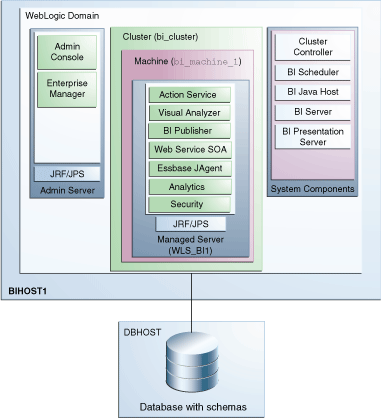1 Understanding Oracle Business Intelligence Installation
Review the following topics thoroughly to ensure that you do not encounter problems during or after installing the product or configuring the domain.
1.1 About Installing a Production Environment
This guide describes how to use Oracle Business Intelligence distribution to install and configure a standard installation topology as a starting point for a production environment.
To install Oracle Business Intelligence in a production environment, Oracle recommends that you download, install, and configure an Oracle Business Intelligence environment on a single host, using this guide.
For more information about scaling out your deployment to multiple Managed Servers and multiple hosts such as in a typical production environment, see Developer's Guide for Oracle Business Intelligence Enterprise Edition for Oracle BI EE and Developer's Guide for Oracle Business Intelligence Publisher for Oracle BI Publisher.
1.2 Using the Standard Installation Topology as a Starting Point
The standard installation topology is a flexible topology that you can use in production environments.
The information in this guide helps you to create a standard installation topology for Oracle Business Intelligence. You can later extend the standard installation topology to create a secure and highly available production environment.
The standard installation topology represents a sample topology for this product. It is not the only topology this product supports. For more information, see "Understanding the Standard Installation Topology" in Planning an Installation of Oracle Fusion Middleware.
1.2.1 Understanding the Business Intelligence Standard Installation Topology
This topology represents a standard WebLogic Server domain that contains an Administration Server and a cluster containing two Managed Servers.
The following figure shows the standard installation topology for Business Intelligence.
See Table 1-1 for information on elements of this topology.

Description of the illustration standard_topo.png
1.2.2 Understanding the Elements in the Standard Installation Topology Illustration
The standard installation topology typically includes common elements.
Table 1-1 describes all elements of the topology illustration.
Table 1-1 Description of the Elements in the Standard Installation Topologies
| Element | Description and Links to Additional Documentation |
| APPHOST | A standard term used in Oracle documentation to refer to the machine that hosts the application tier. |
| DBHOST | A standard term used in Oracle documentation to refer to the machine that hosts the database. |
| WebLogic Domain | A logically related group of Java components (in this case, the Administration Server, Managed Servers, and other related software components).
For more information, see "What is an Oracle WebLogic Server Domain" in Understanding Oracle Fusion Middleware. |
| Administration Server | The central control entity of a domain which maintains the configuration objects for that domain and distributes configuration changes to the Managed Servers.
For more information, see "What is the Administration Server" in Understanding Oracle Fusion Middleware. |
| Enterprise Manager | The Oracle Enterprise Manager Fusion Middleware Control is a primary tool used to manage a domain.
For more information, see "Oracle Enterprise Manager Fusion Middleware Control" in Understanding Oracle Fusion Middleware. |
| Cluster | A collection of multiple WebLogic Server instances running simultaneously and working together.
For more information, see "Understanding Managed Servers and Managed Server Clusters" in Understanding Oracle Fusion Middleware. |
| Machine | A logical representation of the computer that hosts one or more WebLogic Server instances (servers). Machines are also the logical glue between the Managed Servers and the Node Manager. The Managed Servers must be associated with a machine in order to start or stop them using a Node Manager. |
| Managed Server | A host for your applications, application components, web services, and their associated resources.
For more information, see "Understanding Managed Servers and Managed Server Clusters" in Understanding Oracle Fusion Middleware. |
| Infrastructure | Collection of services that include the following:
|
1.3 Using this Document to Extend an Existing Domain
Steps in this document describe how to create a new domain. The assumption is that no other Oracle Fusion Middleware products are installed on your system. All instructions for installation and domain creation are based on this assumption.
If you already have other Oracle Fusion Middleware products installed on your system (for example, you already have Oracle Fusion Middleware Infrastructure installed with a domain that is up and running), you can use the same instructions to extend your existing domain. If you choose to do this, be sure to read "Installing Multiple Products in the Same Domain" in Planning an Installation of Oracle Fusion Middleware for important information.
If you are creating a new domain but your needs do not match the instructions in the procedure, be sure to make your selections accordingly and see supporting documentation for more details.
1.4 Using this Document in an Upgrade Scenario
Upgrade from the 11g environment to the 12c environment is an out-of-place migration, where you would basically migrate the Business Intelligence metadata and configuration from the Oracle 11g instance to the new 12c instance. Migration requires a separate 12c configuration. For the migration procedure, see Migration Guide for Oracle Business Intelligence.